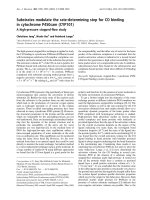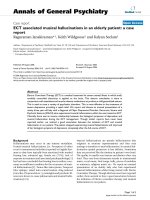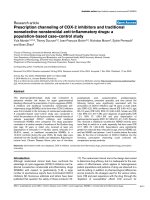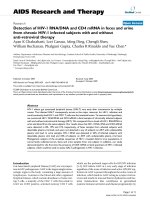Báo cáo y học: "Disseminated tuberculosis presenting with polymorphonuclear effusion and septic shock in an HIV-seropositive patient: a case report" pot
Bạn đang xem bản rút gọn của tài liệu. Xem và tải ngay bản đầy đủ của tài liệu tại đây (817.67 KB, 4 trang )
JOURNAL OF MEDICAL
CASE REPORTS
Nancoz et al. Journal of Medical Case Reports 2010, 4:155
/>Open Access
CASE REPORT
© 2010 Nancoz et al; licensee BioMed Central Ltd. This is an Open Access article distributed under the terms of the Creative Commons
Attribution License ( which permits unrestricted use, distribution, and reproduction in
any medium, provided the original work is properly cited.
Case report
Disseminated tuberculosis presenting with
polymorphonuclear effusion and septic shock in an
HIV-seropositive patient: a case report
Olivier Nancoz*
1
, Omar Kherad
1
, Etienne Perrin
2
, Christophe Hsu
3
, Johannes Alexander Lobrinus
3
and
Mathieu Nendaz
1
Abstract
Introduction: Because a substantial number of patients present with few or atypical symptoms, the recognition of
tuberculosis remains challenging. Disseminated tuberculosis presenting with septic shock has already been described
in some case reports, but, to the best of our knowledge, it has never been associated with polymorphonuclear effusion.
Case presentation: We describe the case of a 27-year-old man from western Africa who was seropositive for human
immunodeficiency virus. He presented with pleural and abdominal polymorphonuclear effusions and quickly
developed septic shock due to disseminated Mycobacterium tuberculosis infection leading to multiple organ failure and
death.
Conclusion: In high-risk patients, Mycobacterium tuberculosis infection should be considered even in exceptional
clinical presentations, such as septic shock and polymorphonuclear effusions.
Introduction
The prevalence of tuberculosis (TB) in developed coun-
tries has decreased since the 1990s, which reflects world-
wide efforts to properly identify and treat TB according
to World Health Organization (WHO) recommenda-
tions. Nevertheless, TB remains a leading problem in
public health, notably because of the poor living condi-
tions of some parts of the population (for example, immi-
grants from countries with a high prevalence of TB) and
the incidence of patients who are seropositive for the
human immunodeficiency virus (HIV). In Geneva, Swit-
zerland, the incidence of TB is 20 per 100,000 for a popu-
lation of 440,000 inhabitants.
Because a substantial number of patients present with
few or atypical symptoms, which mostly, but not exclu-
sively, present in immunocompromised patients, the rec-
ognition of TB remains challenging. The time between
the presentation of symptoms and diagnosis may also
turn out excessively long, with a median delay of 2.1
months in cases documented in Geneva, and even six
months in extreme cases [1].
We describe the case of patient with HIV who pre-
sented with atypical polymorphonuclear effusions and
quickly developed a septic shock due to disseminated TB.
Case presentation
A 27-year-old man from western Africa without any rele-
vant medical history presented to the emergency depart-
ment of our hospital with a two-month history of cough,
intermittent fever, weight loss of 12 kg and profuse diar-
rhea.
On examination, our patient appeared lean at a body
mass index (BMI) of 19 kg/m
2
, with a pulse rate of 116/
minute, blood pressure of 130/90 mmHg, breathing rate
of 25/minute, and temperature of 37.6°C. Results of his
cardiovascular examination were normal. His chest
examination revealed hypoventilation and dullness on
both pulmonary bases. His abdomen was distended and
diffusely tender, with posterior dullness. A psychomotor
agitation with mild confusion was present, without neu-
rological deficit.
* Correspondence:
1
Department of Internal Medicine, Geneva University Hospitals, Geneva,
Switzerland
Full list of author information is available at the end of the article
Nancoz et al. Journal of Medical Case Reports 2010, 4:155
/>Page 2 of 4
Results of his blood tests are shown in Table 1. His HIV
serology test (MEIA
®
, COMBO
®
and Immunoblot
®
)
returned positive. Samples of his blood and urine were
sent for typical bacteriology cultures and returned nega-
tive (after 48 hours for urine and six days for blood). His
chest radiography showed bilateral pleural effusion. An
abdominal ultrasound of our patient revealed the pres-
ence of peritoneal fluid and hepatosplenomegaly, with
parenchymatous hypoechogenic lesions in both organs
and nodular retroperitoneal images.
An analysis of our patient's pleural effusion showed an
exudative fluid with the following values: lactate dehydro-
genase (LDH) 1668 U/L, proteins 57 g/L, and glucose 6.4
mmol/L. There were 1932 leukocytes/mm
3
with 66% neu-
trophils, 22% lymphocytes, 9% plasmocytes, 1% mac-
rophages, 2% mesothelial cells, and 0% eosinophils. His
ascites analysis revealed 3060 leukocytes/mm
3
with 64%
neutrophils, 18% lymphocytes, 15% plasmocytes, and 3%
macrophages. His Gram, acridine and auramine stains
were negative on both fluids upon direct examination. No
acid-fast bacilli could be detected by direct examination
of his sputum.
Results of our patient's transthoracic cardiac echogra-
phy were normal, except for a moderate, inhomogeneous
impairment of his left ventricular ejection fraction (35%
to 40%), with global hypokinesy involving the middle part
of his left ventricle, septum and apex. A native thoracoab-
dominal computed tomography confirmed abdominal
and pleural fluid effusions and showed multiple pulmo-
nary and splenic nodules. It also showed diffuse mesen-
teric and para-aortic adenopathies. Our patient's thoracic
scan is shown on Figure 1.
We then started our patient on an empirical treatment
of imipenem and cilastine, which was completed by a
standard antituberculous quadritherapy of rifampicin,
isoniazid, pyrazinamide, and ethambutol due to high TB
suspicion.
Our patient subsequently developed a rapidly progres-
sive septic shock and died 24 hours later despite attempts
at resuscitation.
An isoniazid-resistant strain of Mycobacterium tuber-
culosis was cultured from our patient's pleural and
Table 1: Blood test result.
Patient value Normal value
Hemoglobin 125 g/L 140-180 g/L
White cell 6.6 G/l 4-11 G/L
Non-segmented neutrophils 18% 0-5%
Platelet 99 G/L 150-350 G/L
C-reactive protein 298 mg/L 0-10 mg/L
Creatinin 270 μmol/L 62-106 μmol/L
Urea (BUN) 24.7 mmol/L 2.6-7.1 mmol/L
ASAT 198 U/L 14-50 U/L
ALAT 48 U/L 12-50 U/L
Alkalin phosphatase 220 U/L 30-125 U/L
Lactate dehydrogenase 1945 U/L 125-240 U/L
Total bilirubin 38 μmol/L 7-25 μmol/L
Conjugated bilirubin 16 μmol/L 2-9 μmol/L
Prothrombin time 85% 80-120%
Partial thromboplastin time 29.6 sec 25-32 sec
ALAT: alanine transaminase; ASAT: aspartate aminotransferase; BUN: blood urea nitrogen.
Figure 1 Computed tomography of the chest with bilateral pleu-
ral effusion and multiple nodular lesions, one of which is excavat-
ed.
Nancoz et al. Journal of Medical Case Reports 2010, 4:155
/>Page 3 of 4
abdominal effusions, as well as from his urine and post-
mortem bronchial aspirations. No other bacteria were
identified. A post-mortem examination performed less
than three hours after his death showed bilateral pleural
effusion (1100 cc on the left and 1220 cc on the right side)
and ascites (2500 cc). Multiple nodules between 1 mm
and 15 mm in size were also observed in his lungs, pleura,
pericardium, liver (2250 g), spleen (490 g, see Figure 2A),
peritoneum and omentum, pancreas, adrenal glands, tho-
racic, abdominal and retroperitoneal lymph nodes, and
bone marrow.
Histologically, the nodules corresponded to necrotizing
granulomas, with very abundant polymorphonuclears
(see Figure 2B). Ziehl-Neelsen staining of these nodules
revealed numerous acid-fast bacteria (see Figure 2C),
while Gram and silver staining did not show any other
bacteria, fungus or parasite. The post-mortem culture of
our patient's tracheal aspirate, lung tissue and omentum
returned positive for M. tuberculosis. No histological
signs of cytomegalovirus or herpetic infections were
present. Apart from esophageal candidiasis, no other
pathological conditions associated with HIV, such as
Pneumocystis jirovecii infection, cerebral toxoplasmosis
or lymphoma, Kaposi sarcoma, or HIV-related lymph-
adenopathy, were found.
Discussion
Despite rapid administration of anti-tuberculosis drugs
after admission, our patient developed a devastating sep-
tic shock with multiple organ failure, diffuse effusions,
and multiple polymorphonuclear rich necrotizing granu-
lomas infiltration of all tissues due to a M. tuberculosis
bacteremia. Of particular interest in this case is the rec-
ognition of potentially misleading features, such as the
presentation of symptoms with a quickly evolving septic
shock, and the presence of polymorphonuclear effusions.
Although most cases of sepsis syndrome have a bacte-
rial or toxic cause, TB presenting with septic shock in
patients with HIV has already been recognized [2-5].
However, to the best of our knowledge, none of these
patients had a polymorphonuclear effusion upon diagno-
sis. Moreover, there is limited information about the epi-
demiological characteristics of patients who are HIV-
negative with M. tuberculosis septic shock. A recent study
summarized the demographic and clinical characteristics
of 27 cases of TB bacteremia in non-HIV patients
reported in the literature [6]. Some case reports describe
miliary tuberculosis, acute empyema, or sepsis and multi-
organ failure [6-9], but, to the best of our knowledge, the
presence of all these conditions in a single patient has
never been documented.
Polymorphonuclear effusions (>60% PMN) is an atypi-
cal and rare hallmark of this tuberculosis case [10].
Although pleural effusion (pleuritis exudativa tubercu-
losa) is a common presentation of TB, it consists of a
serous exudate with a nucleated cell count typically show-
ing more than 85% to 90% lymphocytes [11], which are
interpreted as a delayed hypersensitivity reaction rather
than a direct tuberculous infection [12]. Conversely, rich
polymorphonuclear pleural effusions can be seen in acute
or early forms of direct pleural tuberculous dissemination
(up to the first two weeks) [13] due to a rupture from a
sub-pleural caseous focus, a rupture of a cavitation in the
pleural space, a direct hematogenous spread, or a con-
tamination by adjacent infected lymph nodes or a sub-
diaphragmatic process [9,14]. Such events are more fre-
quently documented in patients with TB parenchymatous
infection.
The direct examination of cultures and early pleural
fluid by Ziehl-Neelsen staining are often insufficient to
confirm the appropriate diagnosis. Indeed, less than 5%
to 10% percent (20% by patients with HIV) of pleural
fluid staining register positive for acid-fast bacilli. More-
over, cultures return positive in 24% to 58%, with the
majority of series showing less than 30% [14], and is lim-
ited by the long delay in obtaining results. The pleural
biopsy for combined histological examination and culture
is the most sensitive diagnostic method, but may still be
falsely negative in 15% to 20% of documented cases [15].
Conclusions
Although septic shock and polymorphonuclear pleural
effusions have both been reported as atypical and rare
Figure 2 (A) Macroscopic transverse section of enlarged spleen
with multiple white creamy nodules. (B) Microscopic view of a pul-
monary granuloma (hematoxylin and eosin stain, magnification 200×).
(C) High magnification microscopic view showing numerous acid-fast
bacilli (Ziehl-Neelsen stain, magnification 600×).
Nancoz et al. Journal of Medical Case Reports 2010, 4:155
/>Page 4 of 4
presentations of tuberculous infection, the association of
these two features makes the situation of our patient even
more unusual. To the best of our knowledge, this associa-
tion has not been previously reported and may represent
a potential diagnostic pitfall. In high-risk patients, M.
tuberculosis infection should be considered even in
exceptional clinical presentation, such as septic shock
and polymorphonuclear effusions. The case of our
patient also illustrates the dramatic consequences of
some forms of this disease, as well as the necessity to ini-
tiate anti-TB drugs quickly, pending confirmation by cul-
ture.
Consent
Written informed consent could not be obtained from
the patient for publication of this because the patient is
now deceased and we were unable to contact a next-of-
kin despite reasonable attempts. Every possible effort has
been made to conceal the identity of the patient and we
believe that a reasonable family would not object to pub-
lication of this case report.
Competing interests
The authors declare that they have no competing interests.
Authors' contributions
ON analyzed and interpreted our patient data and was a major contributor in
writing the manuscript. OK analyzed and interpreted our patient data and was
a major contributor in writing the manuscript. EP analyzed the data and was
involved in drafting the manuscript and revising it critically. CH and JAL per-
formed the autopsy and the histological examination of our patient's spleen
and lungs, and contributed in writing the manuscript. MN analyzed the data
and was involved in drafting the manuscript and revising it critically. All authors
read and approved the final manuscript.
Author Details
1
Department of Internal Medicine, Geneva University Hospitals, Geneva,
Switzerland,
2
Division of Pulmonary Diseases, Geneva University Hospital,
Geneva, Switzerland and
3
Department of Pathology, Geneva University
Hospitals, Geneva, Switzerland
References
1. Kherad O, Herrmann F, Rochat T, Janssens JP: Tuberculosis in Geneva: a
4-year retrospective study. European Respiratory Society Annual Congress:
Stockholm 2007.
2. Clark TM, Burman WJ, Cohn DL, Mehler PS: Septic shock from
mycobacterium tuberculosis after therapy for pneumocystis carinii.
Arch Intern Med 1998, 158:1033-1035.
3. Gachot B, Wolff M, Clair B, Regnier B: Severe tuberculosis in patient with
immunodeficiency virus infection. Intensive Care Med 1990, 16:491-493.
4. Vadillo M, Corbella X, Carratala J: AIDS presenting as septic shock caused
by Mycobacterium tuberculosis. Scand J Infect Dis 1994, 26:105-106.
5. Grigoriu BD, Jacobs FM, Mas AE, Prat D, Prévot S, Brivet FG: Disseminated
tuberculosis with severe multi-organ failure in a patient with AIDS. Rev
Mal Respir 2008, 25(7):853-856.
6. Chiu YS, Wang JT, Chang SC, Tang JL, Ku SC, Hung CC, Hsueh PR, Chen YC:
Mycobacterium tuberculosis bacteremia in HIV-negative patients. J
Formos Med Assoc 2007, 106:355-364.
7. Runo JR, Welch DC, Ness EM, Robbins IM, Milstone AP: Miliary
tuberculosis as cause of acute empyema. Respiration 2003, 70:529-532.
8. Michel P, Barbier C, Loubière Y, Hayon JH, Ricôme JL: Three cases of
septic shock due to tuberculosis without HIV pathology. Intensive Care
Med 2002, 28:1827-1828.
9. Angoulvant D, Mohammedi I, Duperret S, Bouletreau P: Septic shock
caused by Mycobacterium tuberculosis in a non-HIV patient. Intensive
Care Med 1999, 25:238.
10. Sleisenger & Fordtran's gastrointestinal and liver disease. In
Pathophysiology Diagnosis Management Edited by: Feldman M,
Scharschmidt BF, Sleisenger MH. WB Saunders Company; 2002:1522.
11. Pérez-Rodriguez E, Jiménez Castro D, Light RW: Effusions from
tuberculosis. In Textbook of Pleural Diseases Edited by: Light RW, Lee YCG.
London: Arnold Press; 2003.
12. Ferrer J: Pleural tuberculosis. Eur Respir J 1997, 10:942-947.
13. Levine H, Szanto PB, Cugell DW: Tuberculous pleurisy: an acute illness.
Arch Intern Med 1968, 122:329-332.
14. Gopi A, Madhavan SM, Sharma SK, Sahn SA: Diagnosis and treatment of
tuberculous pleural effusion in 2006. Chest 2007, 131:880-889.
15. Trajman A, Pai M, Dheda K, van Zyl R Smit, Zwerling AA, Joshi R, Kalantri S,
Daley P, Menzies D: Novel tests for diagnosing tuberculous pleural
effusion: what works and what does not? Eur Respir J 2008,
31:1098-1106.
doi: 10.1186/1752-1947-4-155
Cite this article as: Nancoz et al., Disseminated tuberculosis presenting with
polymorphonuclear effusion and septic shock in an HIV-seropositive patient:
a case report Journal of Medical Case Reports 2010, 4:155
Received: 24 October 2009 Accepted: 26 May 2010
Published: 26 May 2010
This article is available from: 2010 Nanco z et al; licensee BioMed Central Ltd . This is an Open Access article distributed under the terms of the Creative Commons Attribution License ( ), which permits unrestricted use, distribution, and reproduction in any medium, provided the original work is properly cited.Journal of Medical Case Reports 2010, 4:155









